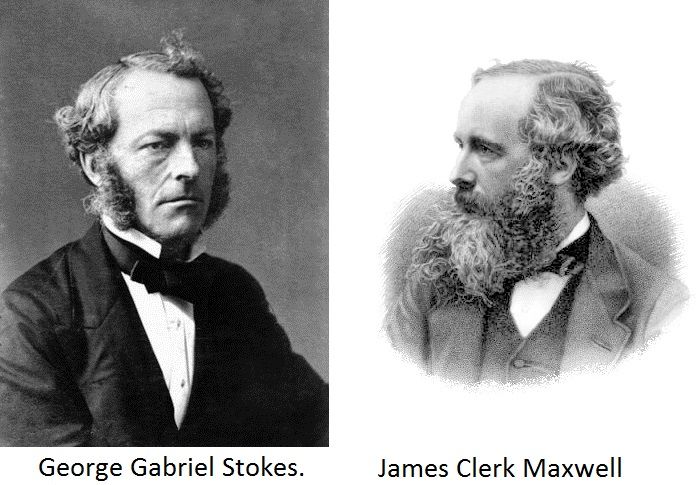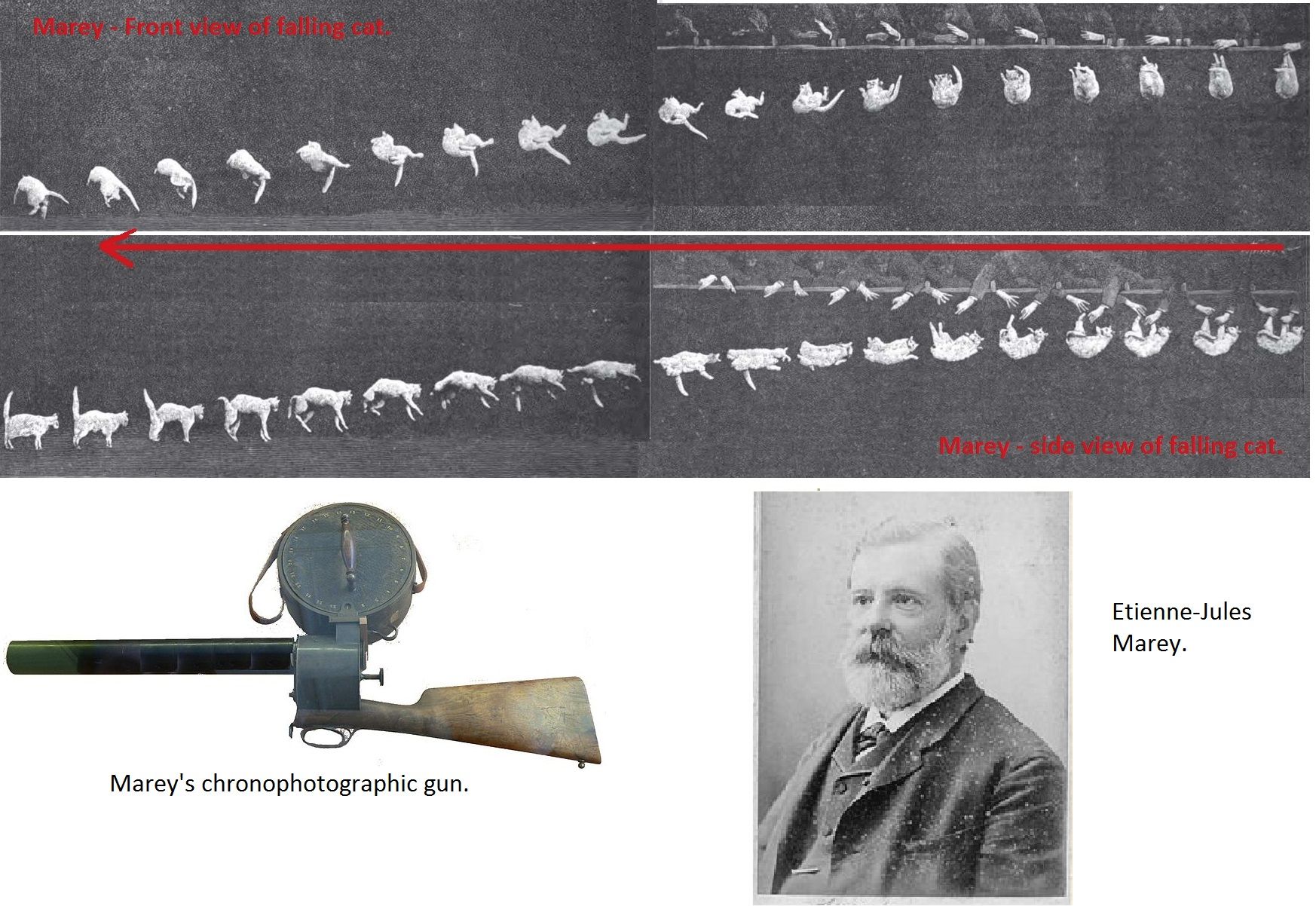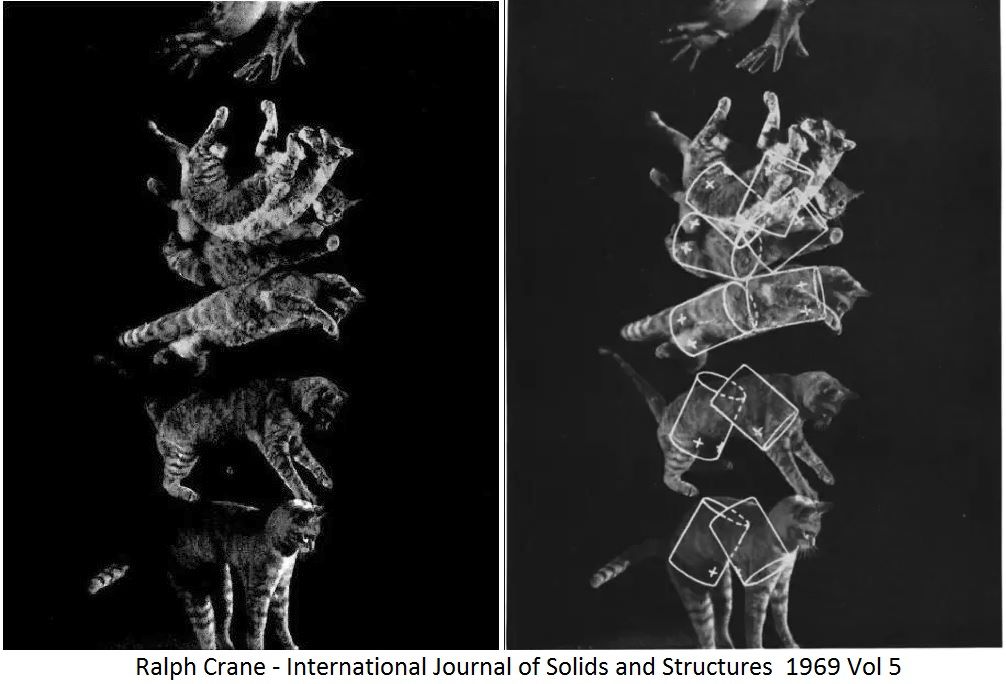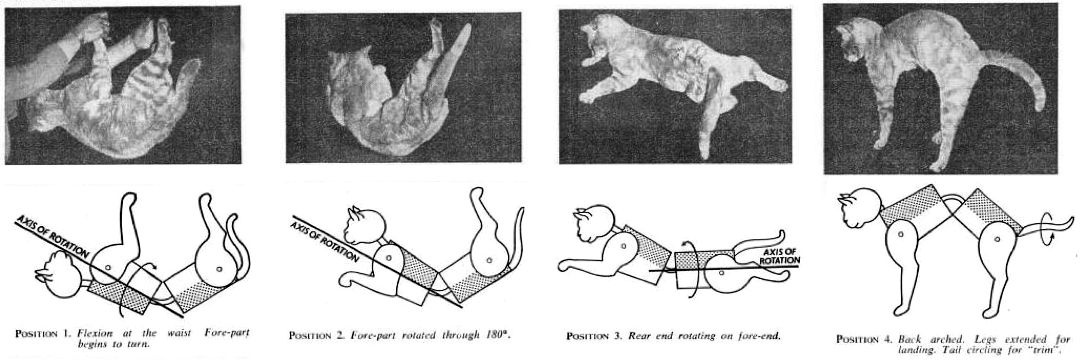
NINETEENTH CENTURY CAT-TURNING AND THE SELF-RIGHTING REFLEX
In the 19th Century, a number of brilliant physicists turned their attention to “the falling cat problem” or the physics of why cats usually landed on their feet in seeming violation of the laws of physics. How can a free-falling body, in this case the cat, change its orientation, regardless of its initial orientation, and land on its feet without breaking the law of conservation of angular momentum? To many onlookers, scientists and mathematicians were engaged in the frivolous pursuit of dropping cats from various heights onto soft surfaces.
What they were studying was the cat’s “self-righting” reflex and the process of self-righting. Reaching a solution was not as straightforward. It would not be until the mid 20th Century that scientists would discover that the apparent contradiction with the law of conservation of angular momentum is resolved because the cat is not a rigid body, but instead changes its shape during the fall. Feline falling behaviour is typical of the mechanics of deformable (flexible) bodies.
THE SELF-RIGHTING REFLEX
The (self-)righting reflex is the cat's innate ability to orient itself as it falls in order to land on its feet. This reflex begins to appear at 3–4 weeks of age, and is perfected at 6–7 weeks. Cats can do this because of their extremely flexible backbone and lack of a functional collarbone. The minimum height required for self-righting safely is around 30 centimetres (12 in) although other sources state 90 cm (3.0 ft) to get their legs safely underneath them. Self-righting makes much use of the hind legs and little use of the tail, so tailless and bobtailed cats still have the self-righting ability.
1 - The cat determines down from up, either visually or with their inner ear apparatus. Then they twist themselves to face downward without changing their net angular momentum.
2 – It bends in the middle so that the front half of the body rotates about a different axis from the rear half.
3 – It tucks in its front legs to reduce the moment of inertia of the front half of its body and extends its hind legs to increase the moment of inertia of the rear half of its body in order to rotate the front half as much as 90° while rotating the rear half in the opposite direction by as little as 10°.
4 – It extends its front legs and tucks in its rear legs in order to rotate its rear half further while rotating its front half in the opposite direction much less.
4 - Depending on the individual cat's flexibility and initial angular momentum, if any, it may repeat steps 3 and 4 in order to complete a full 180° rotation. Hence it appears to be wriggling in mid-air.
In addition to the righting reflex, the cat’s small size, light bone structure, and (optional depending on breed) thick fur decreases its terminal velocity. A falling cat spreads out its head, legs and tail to increase drag. An average-sized cat with limbs extended has a terminal velocity of about 60 mph (97 km/h), about half that of an average man. This distributes the force of impact more evenly throughout the body, but cannot eliminate the possibility of injury if landing on a hard surface (see High-Rise Syndrome below). Is this how gliding squirrels started out? If cats evolved flaps of skin between their fore and hind legs and they could be on the route to gliding from your balcony to the neighbour’s porch!
CAT –TURNING IN THE NINETEENTH CENTURY
In the mid-to-late-1800s, an exciting era in which the foundations of electromagnetic theory were set and the electromagnetic nature of light was discovered, a number of the greatest minds in physics were intrigued by the phenomenon they referred to as “cat-turning,” the ability of felines to land on their feet when dropped from pretty much any orientation and any height. Experiments were performed with feline subjects and at least one paper was written - with photos.
George Gabriel Stokes (1819-1903) was a brilliant physicist and mathematician, and was Lucasian Professor of Mathematics from 1849 until his death (a position also held by Stephen Hawking, Charles Babbage and Isaac Newton). Alongside his work in optics and mathematics, Stokes investigated “cat-turning.” This is how The Morning Post (Monday 15th April 1907, “The Scientific Middleman”) described him: “Even if he be judged merely by the tale of his published work must needs admit that the late Sir George Stokes was the equal of any of the makers of Nineteenth Century Science, nearly all of whom he not only outlived but also outworked. He was the eldest of the three great thinkers—Clerk-Maxwell and Lord Kelvin were the other two—who created the Cambridge school of mathematical physics, and neither of his comrades did more to advance the boundaries our knowledge through that vast region of natural philosophy, which each gain of ground is the result of the combination of mathematical analysis and experimental skill. [. . .] At one time he and Professor Clerk-Maxwell were greatly interested in “cat-turning” - a term invented to describe the way in which a cat contrives to fall upon her feet if you hold her by the four feet and drop her, back downwards, close to the floor. (Memoir and Correspondence of the late Sir George Gabriel Stokes. Selected and arranged by Joseph Larmor, D.Sc., LL.D.; Fellow of St. John’s College, Cambridge, and Lucasian Professor of Mathematics. 2 Vols. Cambridge University Press.)”

According to his daughter Mrs. Laurence Humphry in the 1907 Memoir and Scientific Correspondence of the Late Sir George Gabriel Stokes, “He was much interested, as also was Prof. Clerk Maxwell about the same time, in cat-turning, a word invented to describe the way in which a cat manages to fall upon her feet if you hold her by the four feet and drop her, back downwards, close to the floor. The cat’s eyes were made use of, too, for examination by the ophthalmoscope, as well as those of my dog Pearl: but Pearl’s interest never equalled that of Professor Clerk Maxwell’s dog, who seemed positively to enjoy having his eyes examined by his master.”
James Clerk Maxwell (1831-1879) is better known for his research into electromagnetism and thermodynamics. While studying Mathematics and also Colour Perception at Trinity College in Cambridge he also investigated “cat-turning.” He later recalled those days in an 1870 letter to his wife Katherine Mary Clerk Maxwell (“The Life of James Clerk Maxwell” p. 499.), in which he mentioned the reputation he developed from his research: “There is a tradition in Trinity that when I was here I discovered a method of throwing a cat so as not to light on its feet, and that I used to throw cats out of windows. I had to explain that the proper object of research was to find how quick the cat would turn round, and that the proper method was to let the cat drop on a table or bed from about two inches, and that even then the cat lights on her feet.”
What these eminent men were studying is now known as the “cat righting reflex.” It is something that cats can do by instinct, but was not solved in scientific terms by humans until 1969 (T.R. Kane and M.P. Scher, “A dynamical explanation of the falling cat phenomenon,” International Journal of Solids and Structures 5 (1969), 663-670). A cat in freefall has only the force of gravity acting upon it, and logically should not be able to rotate, or add or subtract to its own angular momentum, but by twisting its body it can rotate itself to land on its feet with violating the laws of physics.
Stokes and Maxwell did not have access to high-speed photography. By the 1890s, Étienne-Jules Marey (1830-1904), a French scientist, physiologist, and cinematography pioneer became interested in animal flight. To aid in his research, he developed a technique called chronophotography to take a rapid series of photographs - 12 frames a second - together on a single picture. In the 1890s that counted as “high-speed.” He built a “chronophotographic gun” (a high speed camera) and took moving images of people and various animals i9n motion, including cats.
Marey’s famous cat-dropping images were first presented in the journal Comptes Rendus in 1894, (É.J. Marey, “Des mouvements que certains animaux exécutent pour retomber sur leurs pieds, lorsqu’ils sont précipités d’un lieu élevé,” Comptes Rendus 119 (1894), 714-717. [Movements that certain animals perform in order to fall on their feet when they are dropped from a high place]) and a summary of his results appeared in Nature magazine that same year (“Photographs of a tumbling cat,” Nature 51 (1894), 80-81.) His images eliminated some of the theories. Because the cat has no rotational motion as it begins to fall, it was clear to Marey that the cat did not cheat and use the person’s hands as a fulcrum to push off of. Marey also deduced from the images that air resistance provided no assistance to the falling feline. Despite the publication of the images, many physicists at the time maintained that the cat was still "cheating" by using the handler's hand from its starting position to right itself, as the cat's motion would otherwise seem to imply a rigid body acquiring angular momentum.

In the summary: “M. Marey thinks that it is the inertia of its own mass that the cat uses to right itself. The torsion couple which produces the action of the muscles of the vertebra acts at first on the forelegs, which have a very small motion of inertia on account of the front feet being foreshortened and pressed against the neck. The hind legs, however, being stretched out and almost perpendicular to the axis of the body, possesses a moment of inertia which opposes motion in the opposite direction to that which the torsion couple tends to produce. In the second phase of the action, the attitude of the feet is reversed, and it is the inertia of the forepart that furnishes a fulcrum for the rotation of the rear.” The author of the Nature summary added: “The expression of offended dignity shown by the cat at the end of the first series indicates a want of interest in scientific investigation.”
The cat “pushes off” of part of its own body to rotate - twisting the front of its body first, with legs pulled in, which moves more than the rear of the body with legs extended. The rotation is completed by reversing the process. A detailed description is more technical than that, of course, and the “kink” in the cat’s back is crucial to making the process work.
The solution of the problem, originally published by Kane & Scher (1969), models the cat as a pair of cylinders (the front and back halves of the cat) capable of changing their relative orientations. This has been further elaborated on by later physicists discussing the dynamics of deformable bodies. (T. R. Kane & M. P. Scher, Department of Applied Mechanics. Stanford University, California, “A Dynamical Explanation Of The Falling Cat Phenomenon,” Int. J. Solids Structures. 1969. Vol. 5. pp. 663 to 670):

“It is well known that falling cats usually land on their feet and, moreover, that they can manage to do so even if released from complete rest while upside-down. This phenomenon has given rise to questions of Dynamics as well as Physiology, and these have received attention in the literature of both fields. In particular, numerous attempts have been made to discover a relatively simple mechanical system whose motion, when proceeding in accordance with the laws of Dynamics, possesses the salient features of the motion of the falling cat. The present paper constitutes such an attempt. The phrase "salient features of the motion" requires elaboration, for its meaning is crucial to the determination of the extent to which a given theory can be regarded as successful. In order to be explicit on this point, we propose the following list of features (see Fig. 1): (I) The torso of the cat bends, but does not twist. (II) At the instant of release, the spine is bent forward. Subsequent to this instant, the spine is bent first to one side, then backward, then to the other side, and finally forward again, at which point the cat has turned over and the spine has the same shape as at the initial instant. (III) The backward bend that occurs during the maneuver is far less pronounced than the initial and terminal forward bend.”
One of the most succinct studies into cat-turning was probably that in the Annals of Improbably Research in 1998 “Does a Cat Always Land on Its Feet?” by Fiorella Gambale, Ph.D. (Institute for Feline Research, Milan, Italy) Gambale believed no one had systematically investigated the limits of this phenomenon and dropped a cat upside down from various heights, observing whether the cat landed on its feet. The results were recorded simply as: “Dropping a Cat Upside Down from a Height of 6 Feet: I dropped the cat from a height of 6 feet. I did this 100 times. The cat always landed on its feet.” This statement was repeated for 5, 4, 3 and 3 feet. But when “Dropping a Cat Upside Down from a Height of 1 Foot: I dropped the cat from a height of 1 foot. I did this 100 hundred times. The cat never landed on its feet.” The conclusion was “Popular belief is that a cat will always land on its feet. My experiments show this to be true for drop heights ranging from six feet down to two feet. It is not true at a drop height of one foot,” adding that for heights less than 1 foot further experiments “preferably with the same cat” were needed. Gambale thanked the cat, "Esther," for her initial cooperation, so presumably Esther got fed up somewhere along the way. One hopes she was suitably rewarded for her participation in this study.
Another problem in studying this phenomenon was noted by Jane Burton and Michael Allaby in their photographic book “Nine Lives, A Year in the Life of a Cat Family.” Having trained some of their cat family to be dropped onto a soft surface from a set height they discovered that one cat became complacent and left it to the last minute to right itself! The cat trusted its human family and was unperturbed at being held upside down and dropped because it knew there was a soft landing. Unlike Gambale’s Esther, who was borrowed from the owner, some cats are natural show-offs.
HIGH-RISE SYNDROME
Cats do not always land uninjured. A 1987 study in the Journal of the American Veterinary Medical Association found that the injuries per cat increased depending on the height fallen up to seven stories, but decreased above seven stories. The authors speculated that after falling five stories the cats reached terminal velocity and thereafter relaxed and spread their bodies to increase drag. There is one fatal (no pun intended) flaw in this study: fatal falls were not included as owners did not take dead cats to the vet, invalidating the conclusion that the injury rate declined for higher falls. A 2003 study concluded that falls from the seventh or higher storeys were associated with more severe injuries and with a higher incidence of thoracic trauma. The cat lands on its feet, the legs act like compressed springs and the chest hits the ground, usually followed by the chin (hence a high incidence of broken jaws).

You are visitor number